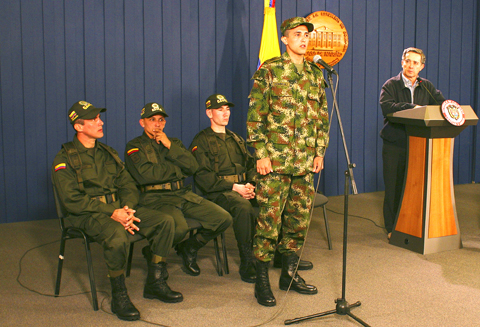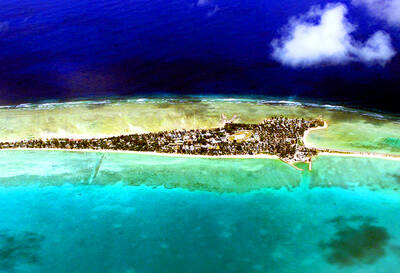Colombia’s embattled guerrillas on Sunday handed over four political hostages, with two more captives set to be released later this week.
The former hostages, who had been held since 2007, were freed in apparently good health, while the Revolutionary Armed Forces of Colombia (FARC) said one rebel was killed and another reported missing after the operation to release the captives.
“It was 20 difficult months,” policeman Juan Fernando Galicia said after getting off the Brazil-provided helicopter that shipped him, two other policemen and a soldier to Villavicencio, 90km southeast of Bogota, at around 7pm.

PHOTO: AP
The four men — part of a group of six hostages the Marxist rebels had promised to free by tomorrow — were to travel to Bogota late on Sunday for medical checkups.
Soldier William Dominguez appealed for the rescue of the remaining hostages, estimated to number between 350 and 700.
“We have to fight for all of the prisoners who are still in the jungle and together, we have to rescue them. We cannot leave them behind,” Dominguez said.
The other two men released were policemen Alexis Torres and Jose Walter Lozano. They were all greeted at the airport terminal by Colombians for Peace, the group that helped broker the handover.
The fate of the hostages had remained uncertain for several hours in the afternoon, after a member of the delegation told Venezuelan TV of Colombian army operations in the area where the captives were released.
“Colombian army aircraft were an obstacle for several hours of the operation,” delegation member Jorge Enrique Botero told Telesur TV.
“There were continuous overflights ... for two hours,” he said, accusing the military of failing to abide by a pledge to halt military activity during the handover and adding that they “almost made the rescue operation fail.”
FARC chief Jairo Martinez told Telesur that one guerrilla had been killed and another was reported missing and possibly captured near the area where the hostages were handed over.
The Colombian government called the accusations “unfounded.”
The International Committee of the Red Cross (ICRC) had previously secured a commitment from the country’s defense minister to halt military operations in Caqueta Province, paving the way for the humanitarian mission.
The four hostages were received in Caqueta by a delegation that included Colombian Senator Piedad Cordoba, representatives of the ICRC and members of Colombians for Peace.
Cordoba played a key role in talks to secure the hostages’ release, a unilateral move that has marked an about-face for the rebels, who had previously ruled out freeing captives without concessions.
A similar operation was set to rescue Alan Jara, a former governor abducted in 2001, yesterday. The rebels were expected to release former lawmaker Sigifredo Lopez, kidnapped in 2002, tomorrow.
Once all six hostages are released, the FARC rebels will only hold 22 “political” hostages. Jara and Lopez are the last politicians held by the group.
The captives are part of a group of so-called “political hostages” the FARC has wanted to swap for some 500 guerrillas held in Colombian and US jails.
In a statement posted online, the FARC had promised on Dec. 21 to release the hostages.

DISASTER: The Bangladesh Meteorological Department recorded a magnitude 5.7 and tremors reached as far as Kolkata, India, more than 300km away from the epicenter A powerful earthquake struck Bangladesh yesterday outside the crowded capital, Dhaka, killing at least five people and injuring about a hundred, the government said. The magnitude 5.5 quake struck at 10:38am near Narsingdi, Bangladesh, about 33km from Dhaka, the US Geological Survey (USGS) said. The earthquake sparked fear and chaos with many in the Muslim-majority nation of 170 million people at home on their day off. AFP reporters in Dhaka said they saw people weeping in the streets while others appeared shocked. Bangladesh Interim Leader Muhammad Yunus expressed his “deep shock and sorrow over the news of casualties in various districts.” At least five people,

ON THE LAM: The Brazilian Supreme Court said that the former president tried to burn his ankle monitor off as part of an attempt to orchestrate his escape from Brazil Former Brazilian president Jair Bolsonaro — under house arrest while he appeals a conviction for a foiled coup attempt — was taken into custody on Saturday after the Brazilian Supreme Court deemed him a high flight risk. The court said the far-right firebrand — who was sentenced to 27 years in prison over a scheme to stop Brazilian President Luiz Inacio Lula da Silva from taking office after the 2022 elections — had attempted to disable his ankle monitor to flee. Supreme Court judge Alexandre de Moraes said Bolsonaro’s detention was a preventive measure as final appeals play out. In a video made

It is one of the world’s most famous unsolved codes whose answer could sell for a fortune — but two US friends say they have already found the secret hidden by Kryptos. The S-shaped copper sculpture has baffled cryptography enthusiasts since its 1990 installation on the grounds of the CIA headquarters in Virginia, with three of its four messages deciphered so far. Yet K4, the final passage, has kept codebreakers scratching their heads. Sculptor Jim Sanborn, 80, has been so overwhelmed by guesses that he started charging US$50 for each response. Sanborn in August announced he would auction the 97-character solution to K4

SHOW OF FORCE: The US has held nine multilateral drills near Guam in the past four months, which Australia said was important to deter coercion in the region Five Chinese research vessels, including ships used for space and missile tracking and underwater mapping, were active in the northwest Pacific last month, as the US stepped up military exercises, data compiled by a Guam-based group shows. Rapid militarization in the northern Pacific gets insufficient attention, the Pacific Center for Island Security said, adding that it makes island populations a potential target in any great-power conflict. “If you look at the number of US and bilateral and multilateral exercises, there is a lot of activity,” Leland Bettis, the director of the group that seeks to flag regional security risks, said in an